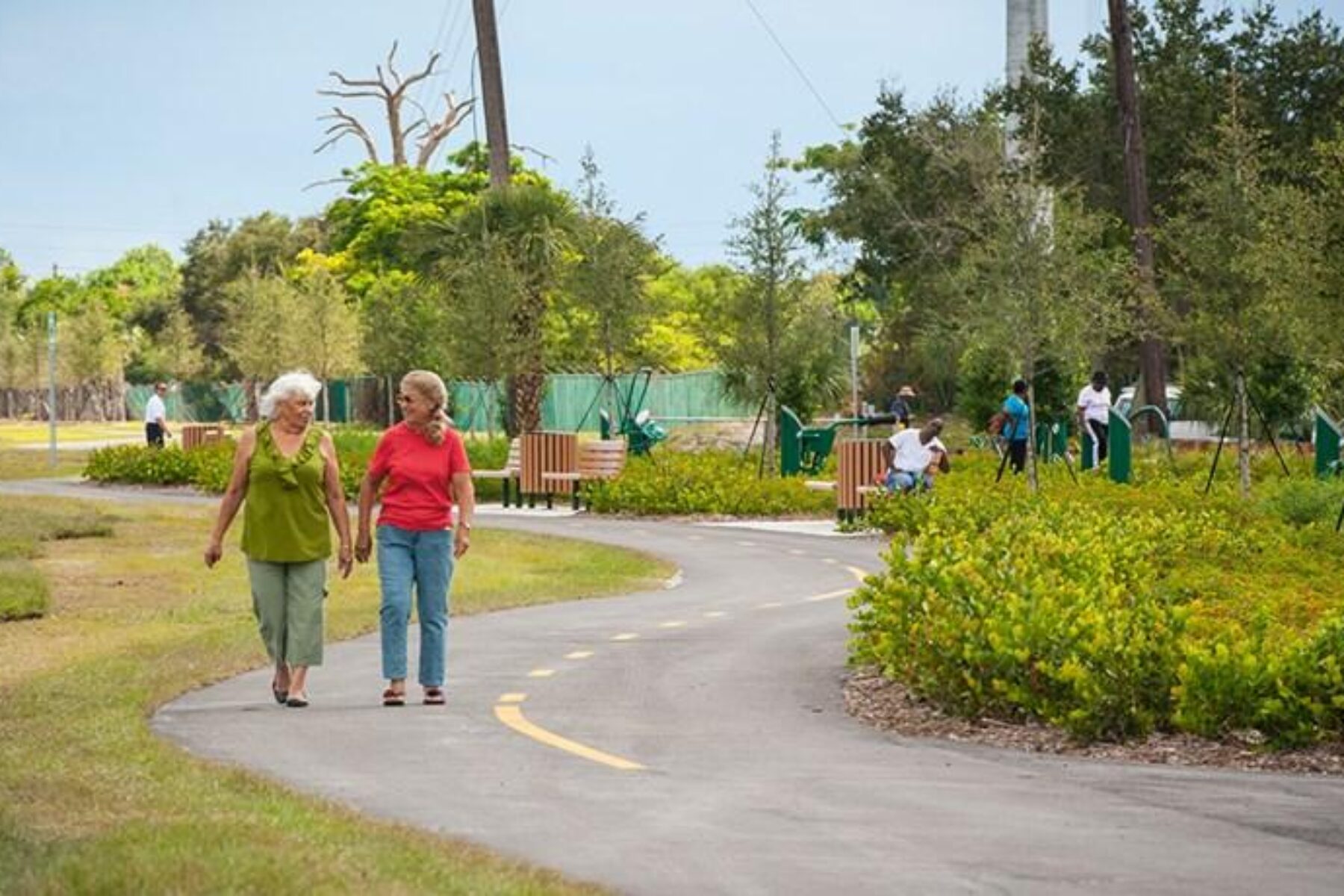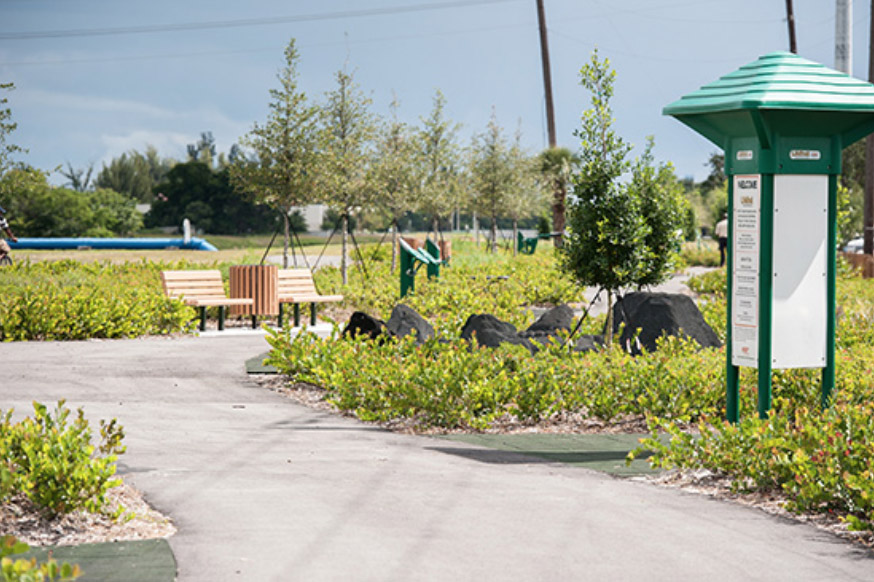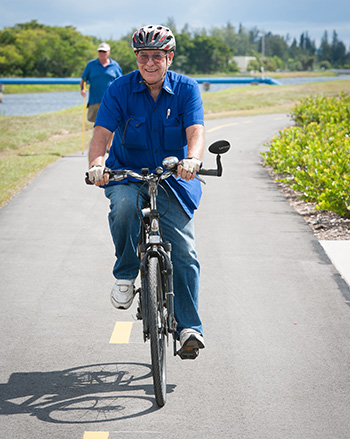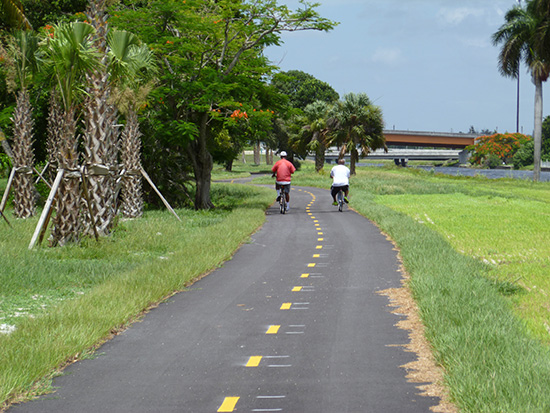Florida’s Snake Creek Trail

Trail of the Month: November 2015
Neighborhood trails don’t come much nicer than the Snake Creek Trail in southeast Florida. While not a rail-trail, the paved 6.5-mile route offers a similar easy and level riding experience along a pleasant, palm-tree-dotted canal connecting North Miami Beach and Miami Gardens (home of the Miami Dolphins). Not only does the canal deliver on views, the 100-foot width of its right-of-way allowed extra room for park space and amenities, like picnic shelters and fitness stations, which further enhanced the trail. The Snake Creek Canal itself, although primarily for flood control, is used for fishing, as well as kayaking, canoeing and jet skiing out to the Biscayne Bay.
“You’re going to see everything: families, people in wheelchairs, inline skaters, old friends walking and talking, even people setting up lawn chairs along the trail.”

“The Snake Creek Trail and canal is extremely vital to the community,” says North Miami Beach parks director Paulette Murphy of the well-loved neighborhood asset. “You’re going to see everything: families, people in wheelchairs, inline skaters, old friends walking and talking, even people setting up lawn chairs along the trail.”
In support of the area’s emerging bike culture, Miami-Dade County launched the Bike305 initiative in 2013 to promote physical activity and healthy lifestyles along the county’s growing trail network. Annual events include many biking events on trails like the Snake Creek.
“In this particular area of the county, there aren’t a lot of neighborhood parks,” says Miami-Dade County Senior Park Planner Mark Heinicke of the diverse, middle- and working-class communities through which the trail runs. “The community was starving for recreational opportunities, and this trail satisfied that need.”

Emphasizing Heinicke’s point, the results of a recent recreation needs assessment survey of Miami-Dade County residents showed that a majority of households felt that maintenance of walking and running paths (91 percent), and bike lanes and paths (81 percent), was “extremely important or important to improve.” A whopping 86 percent also indicated that they would be supportive of the acquisition of open space for biking, walking paths and trails.
Shopping areas, restaurants, and several schools and workplaces are located just off the trail, making it a draw for commuters as well. “One thing that characterizes that area is that there’s a mix of commercial areas and neighborhoods, so there are opportunities for practical trips in addition to recreational and park opportunities,” says David Henderson, bicycle pedestrian administrator for the Miami-Dade Metropolitan Planning Organization.
“The trail counts are actually higher on weekdays than weekends, which shows that there are more practical trips than purely recreational ones,” says Henderson of data collected from a T-MAP counter on the trail’s east end, which he says sees as many as 400 users a day. T-MAP, which stands for Trail Modeling and Assessment Platform, is an RTC research initiative launched last year to study pedestrian and bicycle traffic patterns nationwide for the purpose of creating new useful tools for urban trail planning. The Snake Creek Trail is one of 50 sites selected for the project.

Increasing its value as a transportation corridor is the trail’s proximity to bus routes and the potential development of a station for the Tri-Rail Coastal Link, a commuter line across Miami-Dade, Palm Beach and Broward counties. “There are opportunities to connect it to two new transit facilities,” says Henderson. “A large bus park-and-ride lot just to the west of the trail and a future commuter rail station just to the east.”
The roots of the Snake Creek Trail go back to the 1990s, when it was only about 2 miles long. A 2013 extension, built after a series of public meetings to gather the community’s input, added another few miles. Today, the trail’s strong support and steady usage clearly illustrate the need to keep it growing and improving. A westward extension is being studied to take the trail past Florida’s Turnpike, providing a convenient and traffic-free way to reach the Sun Life Stadium for football games, and longer-term plans call for continuing it still farther west to US 27. An eastern extension would take the trail to Biscayne Boulevard and beyond as soon as a way to get over or under the major thoroughfare is worked out. One day, the already popular trail may stretch as much as 18 miles.
“There’s a lot of support for trail facilities as people look for safe and healthy transportation options,” says Henderson.

The Snake Creek Trail is just one example of a well-integrated trail in the Miami area, and more are coming. Shining a spotlight on Miami’s evolving bike movement is RTC’s upcoming Florida Sojourn, taking place Feb. 29–Mar. 3, 2016. Ken Bryan, RTC’s Florida state director, who is helping to organize the group ride, says the sojourn, which ties together nine trails—a mixture of both rail-trails and greenways—will “weave an interesting story” as it connects a state park (Bill Baggs Cape Florida), several county parks and two national parks (Everglades and Biscayne) on an almost entirely off-road route. On the four-day biking and camping adventure, up to 250 participants will explore both successful established trails and up-and-coming projects like the Ludlam Trail and Biscayne-Everglades Greenway.
“Because it’s so urbanized, you don’t think of Miami as having a regional trail network,” says Bryan. “But there is this emerging system there.”

Donate
Everyone deserves access to safe ways to walk, bike, and be active outdoors.
